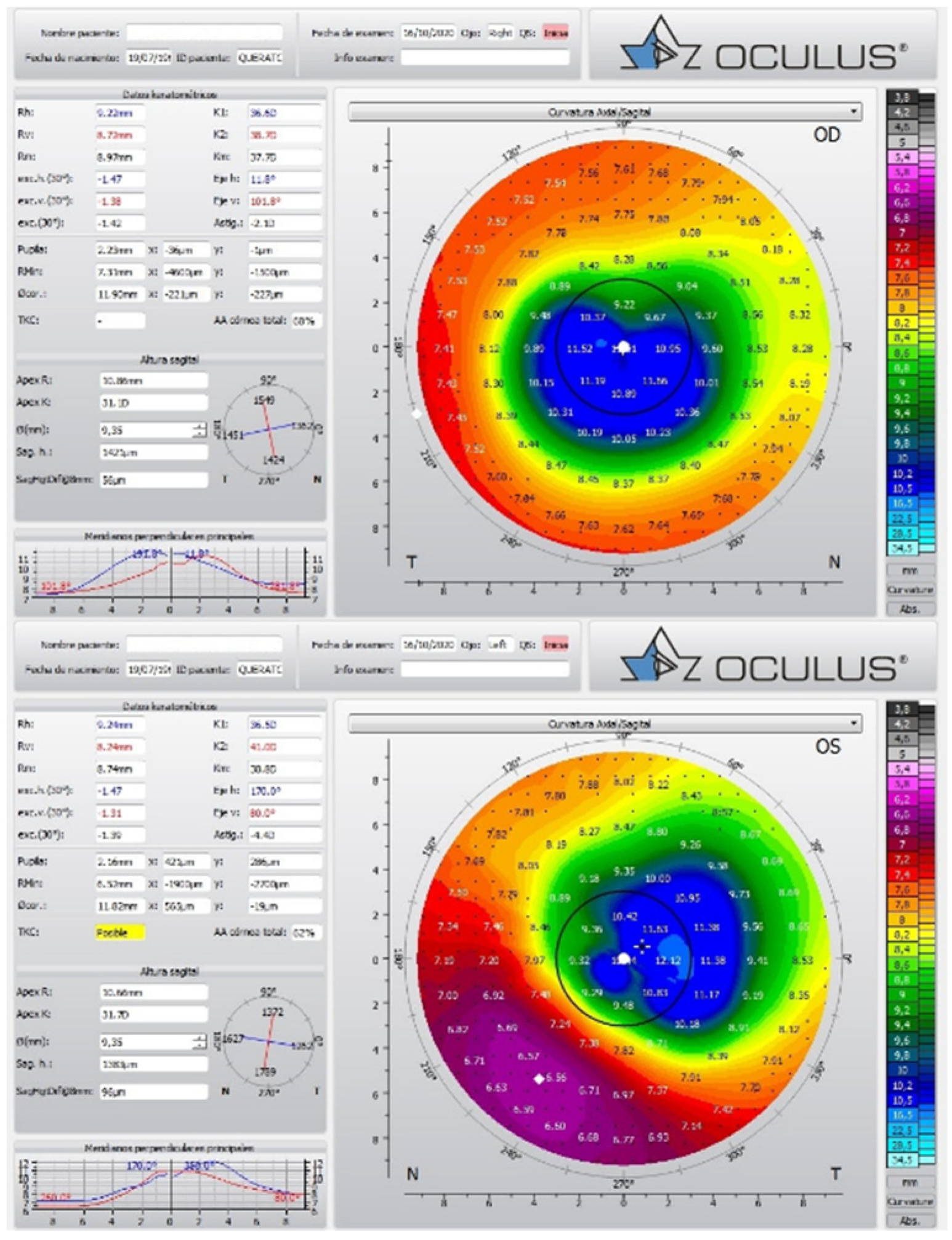Rigid Gas-Permeable Semi-Scleral Contact Lenses after Radial Keratotomy: Apical Space, Lens Diameter, Limbal Clearance, Peripheral O-Rings, and Tear Exchange as Contact-Lens-Fitting Success Factors
Abstract
:1. Introduction
2. Case Report
3. Discussion
4. Conclusions
Author Contributions
Funding
Institutional Review Board Statement
Informed Consent Statement
Data Availability Statement
Acknowledgments
Conflicts of Interest
References
- Mcalinden, C. Corneal refractive surgery: Past to present. Clin. Exp. Optom. 2012, 95, 386–398. [Google Scholar] [CrossRef] [PubMed]
- Parker, J.S.; Dockery, P.W.; Parker, J.S.; Dapena, I.; van Dijk, K.; Melles, G.R.J. Bowman Layer Onlay Graft for Reducing Fluctuation in Visual Acuity After Previous Radial Keratotomy. Cornea 2020, 39, 1303–1306. [Google Scholar] [CrossRef] [PubMed]
- Robin, J.B. Radial keratotomy: Procedures. Indian J. Ophthalmol. 1990, 38, 103–106. [Google Scholar]
- Ghoreishi, M.; Peyman, A.; Koosha, N.; Golabchi, K.; Pourazizi, M. Topography-guided transepithelial photorefractive keratectomy to correct irregular refractive errors after radial keratotomy. J. Cataract Refract. Surg. 2018, 44, 274–279. [Google Scholar] [CrossRef]
- Esen, F.; Toker, E. Influence of Apical Clearance on Mini-Scleral Lens Settling, Clinical Performance, and Corneal Thickness Changes. Eye Contact Lens Sci. Clin. Pract. 2017, 43, 230–235. [Google Scholar] [CrossRef] [PubMed]
- Nau, C.B.; Harthan, J.; Shorter, E.; Barr, J.; Nau, A.; Chimato, N.T.; Hodge, D.O.; Schornack, M.M. Demographic Characteristics and Prescribing Patterns of Scleral Lens Fitters: The SCOPE Study. Eye Contact Lens Sci. Clin. Pract. 2018, 44 (Suppl. 1), S265–S272. [Google Scholar] [CrossRef]
- Vincent, S.J.; Fadel, D. Optical considerations for scleral contact lenses: A review. Contact Lens Anterior Eye 2019, 42, 598–613. [Google Scholar] [CrossRef]
- Macedo-De-Araújo, R.J.; Fadel, D.; Barnett, M. How Can We Best Measure the Performance of Scleral Lenses? Current Insights. Clin. Optom. 2022, 14, 47–65. [Google Scholar] [CrossRef] [PubMed]
- Romero-Rangel, T.; Stavrou, P.; Cotter, J.; Rosenthal, P.; Baltatzis, S.; Foster, C. Gas-permeable scleral contact lens therapy in ocular surface disease. Am. J. Ophthalmol. 2000, 130, 25–32. [Google Scholar] [CrossRef]
- Romero-Jiménez, M.; Flores-Rodríguez, P. Utility of a semi-scleral contact lens design in the management of the irregular cornea. Contact Lens Anterior Eye 2013, 36, 146–150. [Google Scholar] [CrossRef] [PubMed]
- Porcar, E.; Montalt, J.C.; España-Gregori, E.; Peris-Martínez, C. Fitting Scleral Lenses Less Than 15 mm in Diameter: A Review of the Literature. Eye Contact Lens 2020, 46, 63–69. [Google Scholar] [CrossRef] [PubMed]
- Jinabhai, A.N. Customised aberration-controlling corrections for keratoconic patients using contact lenses. Clin. Exp. Optom. 2020, 103, 31–43. [Google Scholar] [CrossRef] [PubMed]
- Kumar, M.; Shetty, R.; Dutta, D.; Rao, H.L.; Jayadev, C.; Atchison, D.A. Effects of a semi-scleral contact lens on refraction and higher order aberrations. Contact Lens Anterior Eye 2019, 42, 670–674. [Google Scholar] [CrossRef] [PubMed]
- Gruenauer-Kloevekorn, C.; Kloevekorn-Fischer, U.; Duncker, G.I.W. Contact lenses and special back surface design after penetrating keratoplasty to improve contact lens fit and visual outcome. Br. J. Ophthalmol. 2005, 89, 1601–1608. [Google Scholar] [CrossRef] [PubMed]
- Chu, H.-S.; Wang, I.-J.; Tseng, G.A.; Chen, W.-L.; Hou, Y.-C.; Hu, F.-R. Mini-Scleral Lenses for Correction of Refractive Errors After Radial Keratotomy. Eye Contact Lens: Sci. Clin. Pract. 2018, 44, S164–S168. [Google Scholar] [CrossRef] [PubMed]
- Fuller, D.G.; Wang, Y. Safety and Efficacy of Scleral Lenses for Keratoconus. Optom. Vis. Sci. 2020, 97, 741–748. [Google Scholar] [CrossRef] [PubMed]




| Parameter | Right Eye | Left Eye |
|---|---|---|
| Lens Model | Rose K2 XL ™ | Rose K2 XL ™ |
| Material | Tisilfocon A (Menicon Z) | Tisilfocon A (Menicon Z) |
| Base Curve [mm] | 6.70 | 6.90 |
| Diameter [mm] | 14.60 | 14.60 |
| Power [Dioptres] | −9.00 | −10.00 |
| Edge Lift Control Peripheral Fit [Degrees] | 45°/135° (Steep −1.50) 225°/315° (Steep −1.00) | 45°/135° (Steep −0.50) 225°/315° (Steep −1.00) |
Publisher’s Note: MDPI stays neutral with regard to jurisdictional claims in published maps and institutional affiliations. |
© 2022 by the authors. Licensee MDPI, Basel, Switzerland. This article is an open access article distributed under the terms and conditions of the Creative Commons Attribution (CC BY) license (https://creativecommons.org/licenses/by/4.0/).
Share and Cite
Capote-Puente, R.; López-Muñoz, A.; Bautista-Llamas, M.-J.; Silva-Viguera, C.; Romero-Luna, M.; Sánchez-González, J.-M. Rigid Gas-Permeable Semi-Scleral Contact Lenses after Radial Keratotomy: Apical Space, Lens Diameter, Limbal Clearance, Peripheral O-Rings, and Tear Exchange as Contact-Lens-Fitting Success Factors. Optics 2022, 3, 209-215. https://doi.org/10.3390/opt3030020
Capote-Puente R, López-Muñoz A, Bautista-Llamas M-J, Silva-Viguera C, Romero-Luna M, Sánchez-González J-M. Rigid Gas-Permeable Semi-Scleral Contact Lenses after Radial Keratotomy: Apical Space, Lens Diameter, Limbal Clearance, Peripheral O-Rings, and Tear Exchange as Contact-Lens-Fitting Success Factors. Optics. 2022; 3(3):209-215. https://doi.org/10.3390/opt3030020
Chicago/Turabian StyleCapote-Puente, Raúl, Alfredo López-Muñoz, María-José Bautista-Llamas, Carmen Silva-Viguera, Marta Romero-Luna, and José-María Sánchez-González. 2022. "Rigid Gas-Permeable Semi-Scleral Contact Lenses after Radial Keratotomy: Apical Space, Lens Diameter, Limbal Clearance, Peripheral O-Rings, and Tear Exchange as Contact-Lens-Fitting Success Factors" Optics 3, no. 3: 209-215. https://doi.org/10.3390/opt3030020
APA StyleCapote-Puente, R., López-Muñoz, A., Bautista-Llamas, M.-J., Silva-Viguera, C., Romero-Luna, M., & Sánchez-González, J.-M. (2022). Rigid Gas-Permeable Semi-Scleral Contact Lenses after Radial Keratotomy: Apical Space, Lens Diameter, Limbal Clearance, Peripheral O-Rings, and Tear Exchange as Contact-Lens-Fitting Success Factors. Optics, 3(3), 209-215. https://doi.org/10.3390/opt3030020







